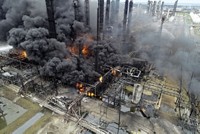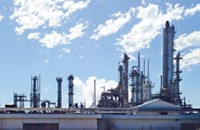Advertisement
Grab your lab coat. Let's get started
Welcome!
Welcome!
Create an account below to get 6 C&EN articles per month, receive newsletters and more - all free.
It seems this is your first time logging in online. Please enter the following information to continue.
As an ACS member you automatically get access to this site. All we need is few more details to create your reading experience.
Not you? Sign in with a different account.
Not you? Sign in with a different account.
ERROR 1
ERROR 1
ERROR 2
ERROR 2
ERROR 2
ERROR 2
ERROR 2
Password and Confirm password must match.
If you have an ACS member number, please enter it here so we can link this account to your membership. (optional)
ERROR 2
ACS values your privacy. By submitting your information, you are gaining access to C&EN and subscribing to our weekly newsletter. We use the information you provide to make your reading experience better, and we will never sell your data to third party members.
Safety
Chemical Safety Board Chairman Is Leaving
Tumultuous tenure coming to an end for Rafael Moure-Eraso
by Jeff Johnson
March 9, 2015
| A version of this story appeared in
Volume 93, Issue 10

During his nearly five years as chairman of the Chemical Safety & Hazard Investigation Board (CSB), Rafael Moure-Eraso has weathered times that were turbulent for both him and the independent board. Now, Moure-Eraso says he’ll leave the board when his term ends in June.
In its role investigating chemically related industry accidents, the small, meagerly funded board has sifted through the accident debris and records of some of the world’s largest chemical plants, refineries, and other companies. The board has sought to discover the root cause of the nation’s most deadly and destructive accidents and, if possible, identify and prevent similar problems that other companies will face in the future.
However, during much of Moure-Eraso’s nearly half-decade as chairman, the board has frequently appeared to be overwhelmed by its responsibilities. Former employees, government investigators, members of Congress, and even board members have charged that Moure-Eraso and his top staffers have mismanaged CSB and created a hostile and toxic work environment at the agency.
Last year, a half-dozen Republicans in the House of Representatives called for the chairman’s resignation, primarily based on charges by unnamed ex-employees and disgruntled board members. One board member even resigned because of disagreements with Moure-Eraso.
Adding heat to complaints about Moure-Eraso’s management of CSB is the Office of Inspector General for the Environmental Protection Agency, which has oversight authority for the board. The Inspector General’s Office has criticized Moure-Eraso and other CSB top officials for hindering its investigations of the board. Recently, Congress has cast a spotlight on those disagreements through hearings and reports, blaming Moure-Eraso and calling for his departure (C&EN, Sept. 1, 2014, page 40).
Despite the allegations, the quality of CSB’s accident reports and safety videos has been unchallenged. Those products are of great value, say safety experts, industry officials, and engineering professors. They note that CSB, under Moure-Eraso’s leadership, has expanded the board’s investigations into academic settings by releasing reports, videos, and recommendations aimed at high school and university chemistry labs.
Detractors and supporters alike criticize the length of time CSB takes to complete accident reports and raise concerns over disharmony within the organization. Many say Moure-Eraso’s departure may offer a chance to push a reset button for the troubled CSB.
In a reflective interview, Moure-Eraso identifies key successes during his tenure on the board—particularly several investigations of refinery accidents. He notes his views and testimony on important accidents have been often sought by anxious members of Congress, such as Sens. Barbara Boxer (D-Calif.) and David Vitter (R-La.), who disagree on many subjects but share deep concerns about deadly chemical accidents in their states.
“We have learned a lot of good lessons, and today the board is stronger and more productive than when I came in. I have the evidence to demonstrate that,” Moure-Eraso says. “In 2010, when I walked in, I was handed 22 incomplete investigations. That is a lot.”
CSB has trimmed its backlog of ongoing investigations to six today. However, to reach that number, it canceled three long-delayed investigations that it appeared likely to have little chance of completing, according to CSB staff.
Much of the work during Moure-Eraso’s term was spent wrapping up those 22 investigations. The board initiated 14 new accident investigations in the past four-and-a-half years. Almost half of these were sought by members of Congress. While lawmakers pushed for new investigations, they failed to provide funds for CSB to do the job, Moure-Eraso points out.
Resources have been a problem for CSB since it began operating in the 1990s. Its funding and staffing have remained at about $9 million to $11 million annually and 40 employees, about half of whom are investigators. Because of limited resources, CSB must carefully select which accidents to investigate since each year several hundred incidents occur in the U.S. that are significant enough to justify a probe.
Moure-Eraso points to four classes of accident investigations conducted during his time on the board that he says will strongly influence CSB’s future. One consists of refinery accidents at a Chevron facility in Richmond, Calif., and a Tesoro site in Anacortes, Wash. Another is a string of three combustible dust explosions at the Hoeganaes Corp. facility in Gallatin, Tenn. A third is the BP Deepwater Horizon-Macondo oil rig disaster in the Gulf of Mexico. The last is the West, Texas, ammonium nitrate farm warehouse explosion. Collectively, these five accidents killed 37 workers and emergency personnel, sent more than 15,000 community members to nearby hospitals, and wreaked billions of dollars in damage.

“The Chevron and Tesoro refinery accident investigations,” he says, “resulted in specific recommendations to modernize and improve process safety management [PSM] requirements that haven’t been touched since 1992. Our finding is that PSM had failed to prevent these accidents from happening.”
PSM is an analytical tool requiring close examination of chemical manufacturing processes. CSB and the Occupational Safety & Health Administration have long sought to have it toughened. “We want to make PSM a real risk-reduction requirement,” he says, “a regulation that requires a company take action, not simply a description of a hazardous process.”
Because of CSB’s refinery accident reports, Moure-Eraso says, regulators in California and Washington are developing new state worker safety regulations to require PSM improvements.
On the flip side, however, these two investigations led to problems for CSB. Members of Congress and state officials blasted the board because of the four-year delay in issuing the Tesoro accident report and recommendations. Meanwhile, the first draft of CSB recommendations in the wake of the Chevron incident included a sweeping regulatory overhaul that deeply split the board. It also led to the resignation of a board member who was displeased with both the recommendations and Moure-Eraso’s handling and management of the review.
The Hoeganaes report, meanwhile, was one of several CSB investigations of dust explosions, Moure-Eraso notes. But the Hoeganaes accidents galvanized CSB staff to push OSHA to develop a national dust regulation, he says.
The Deepwater-Macondo oil rig investigation carved out a whole new area for CSB to investigate—offshore oil and gas drilling accidents. The CSB probe provided new information about the rig’s blowout preventer that failed and led to the massive oil leak. To complete its investigation, Moure-Eraso says, the board had to overcome jurisdictional disputes with state and federal agencies as well as legal challenges from potentially responsible companies.
Finally, the West fertilizer depot explosion led to near total destruction of the small town and the deaths of unprepared emergency responders, he explains. It brought national attention to the mostly unregulated use of a commonplace chemical, ammonium nitrate fertilizer. The board’s congressional testimony and interim accident investigation report contributed to President Barack Obama’s decision to issue his 2013 executive order calling for a reexamination of federal safety regulations, Moure-Eraso says.
Members of Congress ordered CSB to conduct the West, Deepwater-Macondo, and Chevron investigations, which were all large and expensive. Despite the workload jump, Moure-Eraso supports the requests.
“These members are not asking for special favors. These accidents have had a major impact on their communities. But we have to pull investigators from one site to another, and it drives the staff crazy. We try to do two investigations at the same time,” he says. “But things get delayed.”
He singles out the Macondo investigation that was ordered by former Rep. Henry A. Waxman (D-Calif.). “We hoped the request would include a modest funding increase. We developed a budget and estimated the investigation would cost $5.5 million. Waxman told us he would look into it, but nothing happened.”
Funding will be the biggest problem for whoever takes CSB’s helm, he says.
When asked about his legacy, Moure-Eraso says, “In nearly five years with little investment from the federal government, we have produced several reports with great impact on state and federal governments. We have gone through a kind of learning curve because of the big cases we have undertaken. We have more basic knowledge. We are better and stronger than when I started out.”
Accidents will continue, he says, pointing to the recent deaths of four workers at DuPont’s La Porte, Texas, facility. DuPont, he adds, is considered a safety leader and has developed and markets its own safety training programs. “Apparently, DuPont forgot what it is teaching,” he says.
When Moure-Eraso came to the board, he had been a professor in the School of Health & Environment at the University of Massachusetts, Lowell, for 22 years. Previously, he had worked as an industrial hygienist for several labor unions. Moure-Eraso, 68, began his career as a chemical engineer with stints at Rohm and Haas and Dow Chemical.
Come June, Moure-Eraso doesn’t plan to return to academia, he says, but intends to write and consult. “This is a time for reflection,” he says.





Join the conversation
Contact the reporter
Submit a Letter to the Editor for publication
Engage with us on Twitter